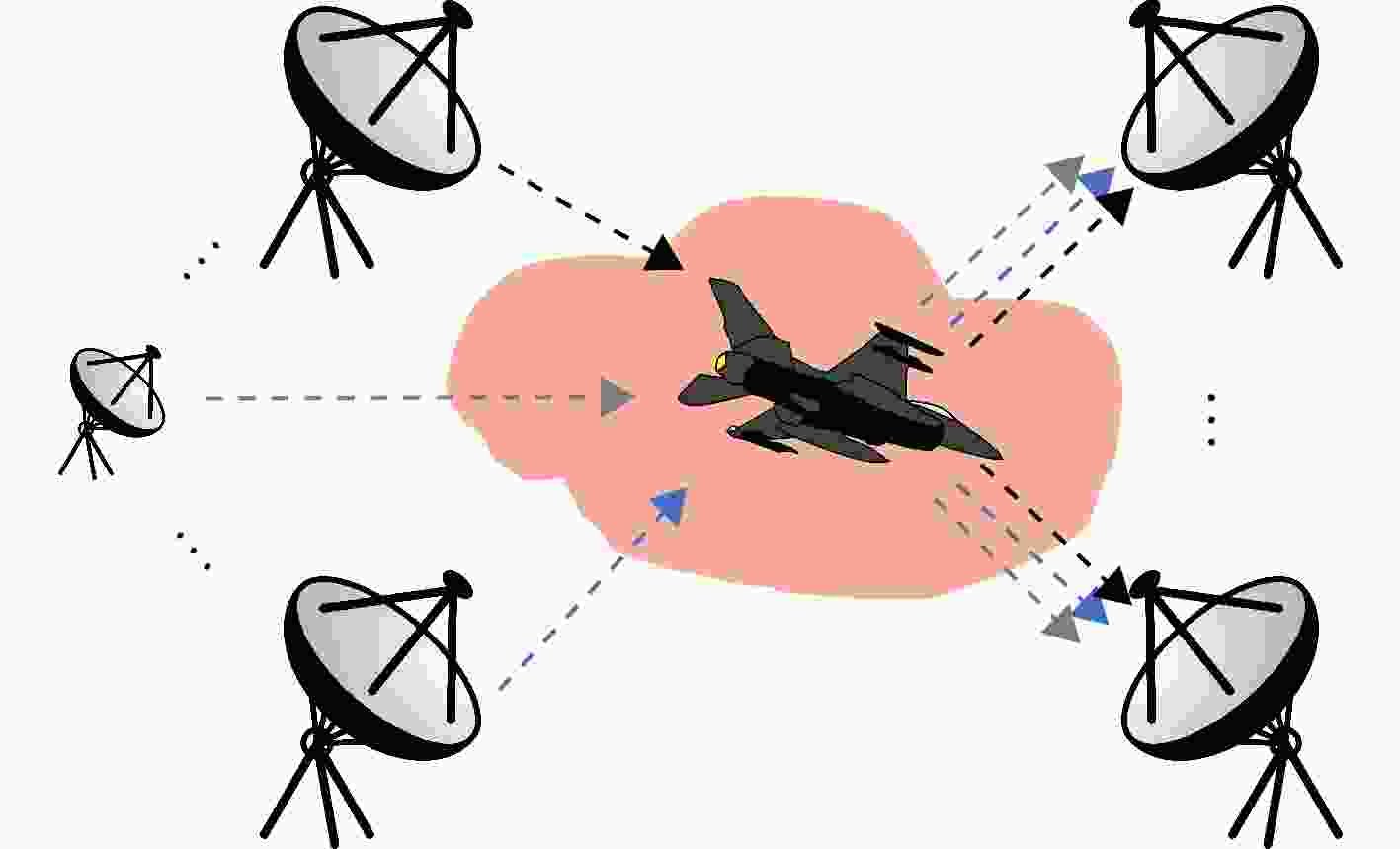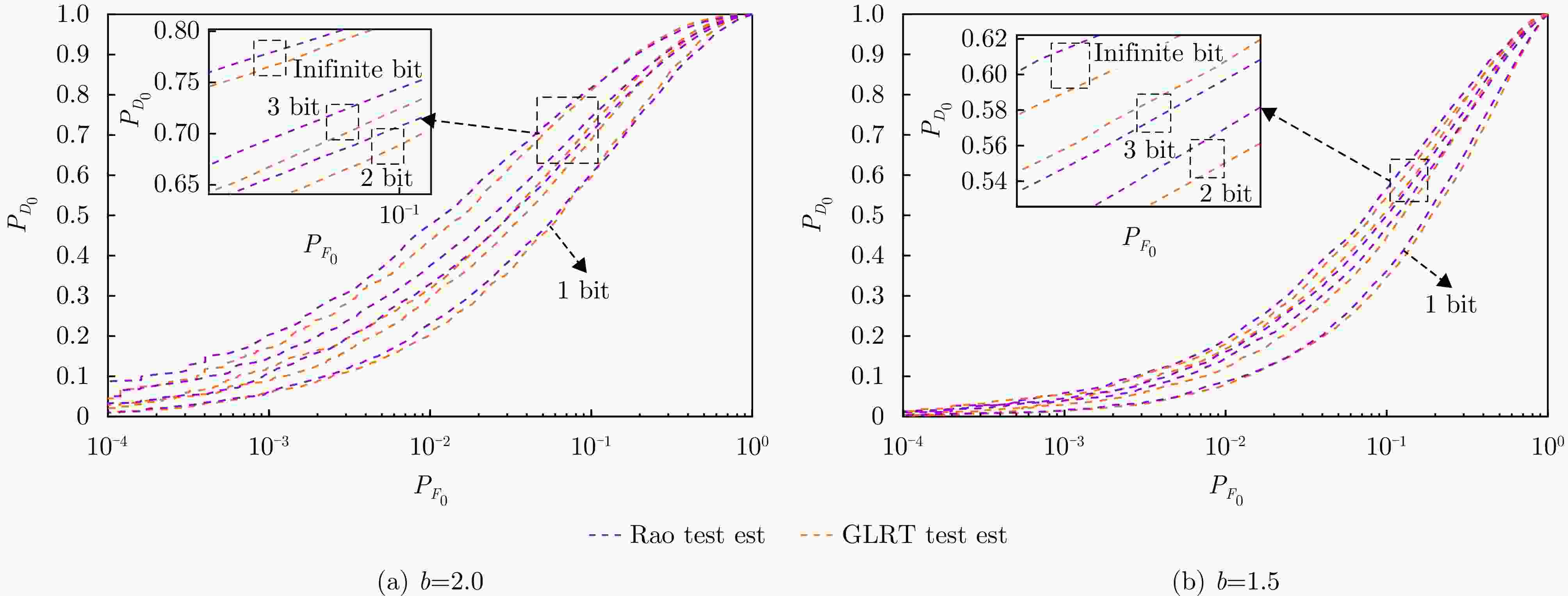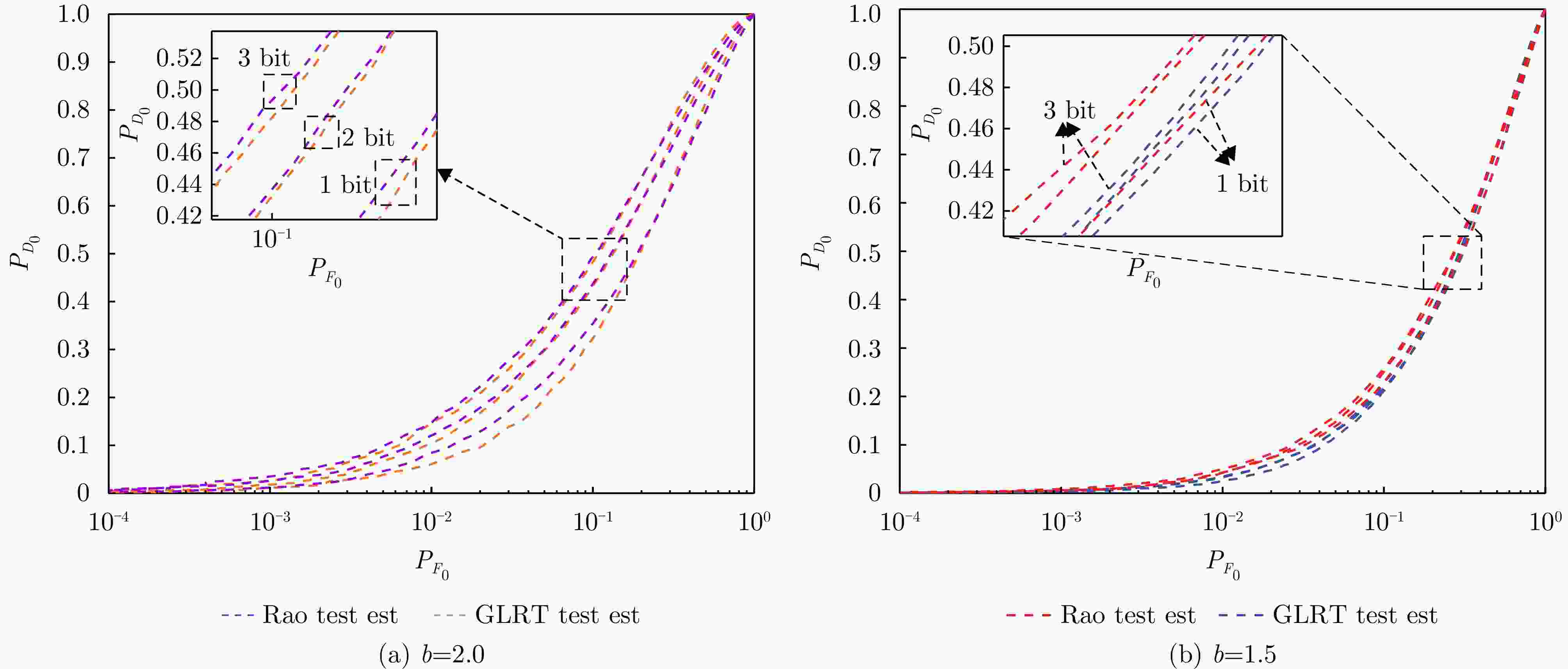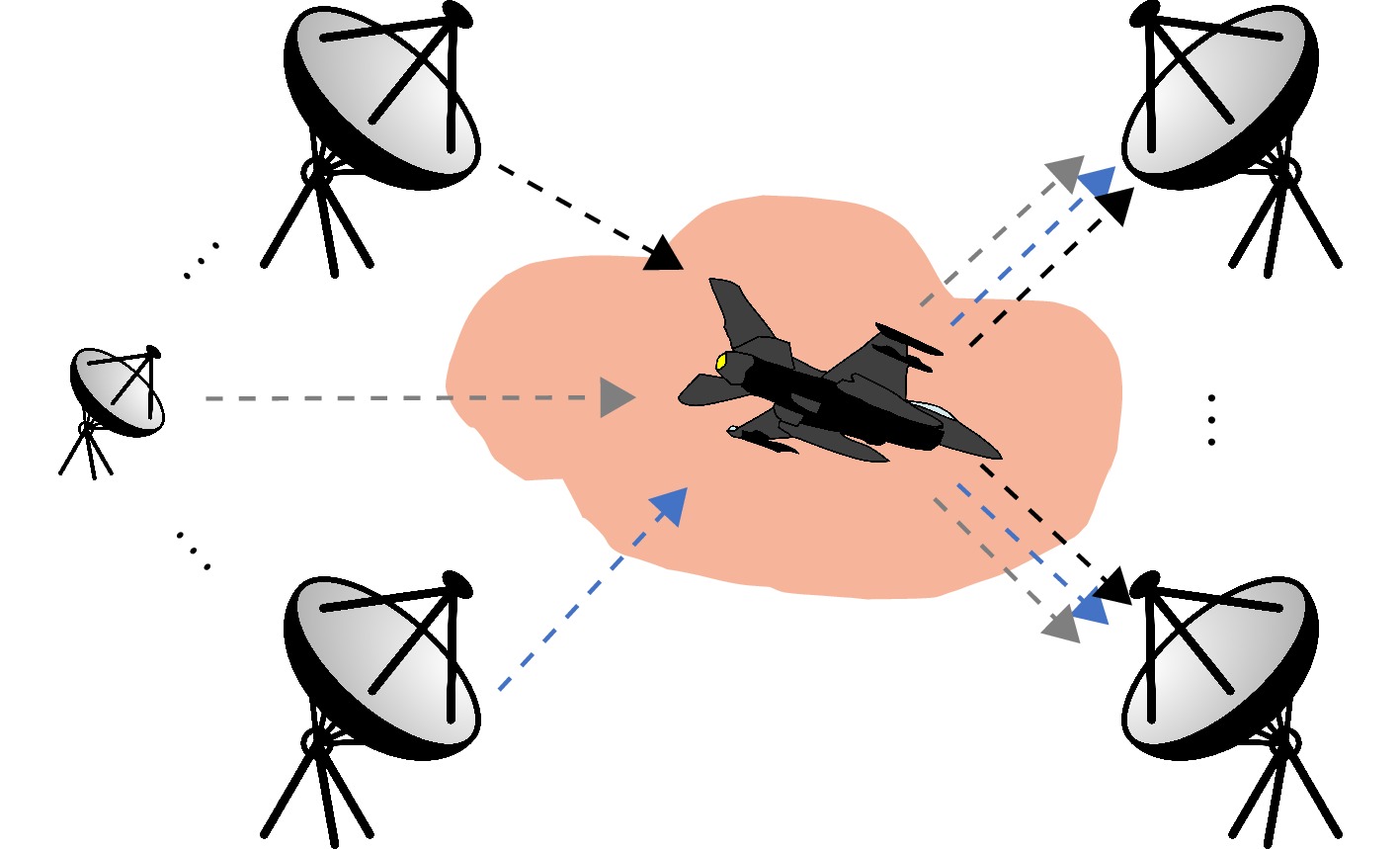Moving Target Detection Using Distributed MIMO Radar Based on Low-bit Quantization Under the Background of Generalized Gaussian noise
-
摘要: 多通道观测数据信号级协同检测是分布式MIMO雷达目标检测的关键技术之一,但该技术在实施过程中需消耗大量系统资源用于数据计算与传输,使其在实际工程应用中面临诸多挑战。鉴于低比特量化技术可显著降低分布式系统的通信传输代价和计算资源消耗,该文研究了广义高斯噪声背景下基于低比特量化的MIMO雷达目标检测问题。分别基于广义似然比检验(GLRT)与广义Rao (G-Rao)检验设计了相应的检测器:前者需要对目标反射系数与多普勒频率进行最大似然估计;后者基于得分函数直接构造统计量,避免冗余参数搜索,有效降低计算复杂度。此外,为改善检测性能,运用动态规划(DP)算法对量化门限进行优化。实验结果表明:与GLRT方法相比,G-Rao检测器的计算效率更高;与均匀量化门限相比,门限优化可有效提高对目标的检测性能;与粒子群优化等现有算法( PSOA)相比,DP的计算复杂度更低。Abstract: Signal-level cooperative detection based on multichannel observations is a pivotal technique in distributed Multiple-Input Multiple-Output (MIMO) radar for probing targets via the joint processing of multiple echo channels. However, such cooperative processing imposes substantial demands on computational and communication resources. To address this challenge, moving target detection using distributed MIMO radar with low-bit quantization in the presence of generalized Gaussian noise was investigated herein. In particular, the detectors were designed based on the Generalized Likelihood Ratio Test (GLRT) and the Generalized Rao (G-Rao) test. The maximum likelihood of the target reflection coefficient and Doppler frequency is estimated using the GLRT, whereas the G-Rao test directly constructs statistics based on a score function. These methods avoid redundant parameter searches and effectively reduce computational complexity. A Dynamic Programming (DP) algorithm was used to optimize the quantization threshold and improve the detection performance. Experimental results demonstrate that the G-Rao test is more computationally efficient than the GLRT method. In addition, threshold optimization considerably improves target detection performance compared with a uniform quantization threshold, and DP exhibits lower computational complexity than existing algorithms, such as Particle Swarm Optimization (PSOA).
-
1 拟牛顿法求解最大似然估计
1. Quasi-Newton method for maximum likelihood estimation
1. 初始化$ \theta _n^{(0)} $(令$ \beta _n^{(0)} = 0 $,$ f_d^{n(0)} = 0 $),近似Hessian矩阵$ {{\boldsymbol{B}}^{(0)}} = {\boldsymbol{I}} $。 2. 每次迭代$ k = 0,1,2,\cdots $,计算当前梯度$ {{\boldsymbol{g}}^{(k)}} = \nabla _{{\theta _n}}^{(k)} $; 解线性方程$ {{\boldsymbol{B}}^{(k)}}{{\boldsymbol{d}}^{(k)}} = + {{\boldsymbol{g}}^{(k)}} $,得到上升方向$ {{\boldsymbol{d}}^{(k)}} $; 作一维精确/近似线搜索,找步长$ {\alpha }^{(k)} $使$ L({\boldsymbol{\theta}} _n^{(k)} + \alpha {{\boldsymbol{d}}^{(k)}}) $; 更新参数$ {{\boldsymbol{\theta}} }_{n}^{(k+)}={{\boldsymbol{\theta }}}_{n}^{(k)}+{{{\alpha }}}^{(k)}{{\boldsymbol{d}}}^{(k)} $并计算$ {\boldsymbol{s}}_n^{(k)} = \theta _n^{(k + 1)} - \theta _n^{(k)},\;{\boldsymbol{y}}_n^{(k)} = {{\boldsymbol{g}}^{(k + 1)}} - {{\boldsymbol{g}}^k} $,得到 $ {{\boldsymbol{B}}^{(k + 1)}} = {{\boldsymbol{B}}^{(k)}} - \dfrac{{{{\boldsymbol{B}}^{(k)}}{{\boldsymbol{s}}^{(k)}}{{\boldsymbol{s}}^{(k) \top }}{{\boldsymbol{B}}^{(k)}}}}{{{{\boldsymbol{s}}^{(k) \top }}{{\boldsymbol{B}}^{(k)}}{{\boldsymbol{s}}^{(k)}}}} + \dfrac{{{{\boldsymbol{y}}^{(k)}}{{\boldsymbol{y}}^{(k) \top }}}}{{{{\boldsymbol{y}}^{(k) \top }}{{\boldsymbol{s}}^{(k)}}}} $ 3. 检查收敛:若$ \Vert {{\boldsymbol{g}}}^{(k+1)}{\Vert }_{2} $或$ \Vert {{\boldsymbol{s}}}^{(k)}{\Vert }_{2}\le $$ \varepsilon $, $ (\varepsilon > 0) $,则输出结果$ {\boldsymbol{\theta}} _n^* = {[\beta _n^{R*},\beta _n^{I*},f_d^{n*}]^{\rm T}} $ 2 采用PSOA算法优化量化门限$ \tau $
2. Optimization of the quantization threshold $ \tau $ using the PSO algorithm
输入 $ \tau_{\text{max,}}q,M,v_{{\mathrm{tol}}},\omega ,c_1,c_2 $ 输出 $ {\tau ^*} = {{\mathrm{s}}_{\rm{best}}^l} $全局最优解 步骤1. 初始化阶段 步骤1.1 对于每个粒子$ m \in \{ 1,2,\cdots,M\} $ 步骤1.2 随机生成初始位置$ \tau _m^0 $和速度$ v_m^0 $ 步骤1.3 计算目标函数值$ c(\tau _m^0) $ 步骤1.4 设置个体最优$ {\mathrm{p}}_{{\rm{best}}m}^0 $ 步骤2. 迭代更新阶段 步骤2.1 迭代次数$ l = 0 \sim L\max - 1 $ 粒子$ m \in \{ 1,2,...,M\} $生成随机数$ r1,r2 \sim U(0,1 $) 步骤2.2 更新速度 $ v_m^{l + 1} = w \cdot v_m^l + {c_1}{r_1}({p_{{\text{best}},m}} - \tau _m^l) + {c_2}{r_2}({g_{{\text{best}}}} - \tau _m^l) $ 步骤2.3 更新位置 $ \tau _m^{l + 1} = \tau _m^l + v_m^{l + 1} $ 步骤2.4 位置约束处理 如果$ |\tau _m^{l + 1}| > \tau_{\text{max}} $ $ \tau _m^{l + 1} = {\mathrm{sign}}(\tau _m^{l + 1}) \cdot \tau_{\max} $ 步骤2.5 计算新目标值$ c(\tau _m^{l + 1}) $ 更新个体最优 如果$ c(\tau _m^{l + 1}) > c({\mathrm{p}}_{{\rm{best}}m}^l) $ 则$ {\mathrm{p}}_{{\rm{best}}m}^l = \tau _m^{l + 1} $ 由(46)更新全局最优 步骤3. 返回$ {\tau ^*} = {{\mathrm{s}}_{\rm{best}}^l} $ 3 采用DP算法优化量化门限$ \tau $
3. Optimization of the quantization threshold $ \tau $ using the DP algorithm
输入 $ \tau_{\text{max}},q,M,L,T_0 $ 输出 $ {\tau ^*} = {\mathrm{Taubest}} $全局最优解 步骤1. 网格划分 将$ [ - \tau_{\max} ,\tau_{\max} ] $等分为$ {\tau _{{\mathrm{grid}}}}[1..L] $ 步骤2. 预计算G矩阵(量化相关参数) 计算所有量化组合的G值:$ G_{\mathrm{mat}} $ 矩阵所有元素和:$ G_{\mathrm{sum}} $ 步骤3. 计算每个区间$ (i,j) $的贡献$ C\left( {i,j} \right) $ 第一层遍历从$ i = 1 $到L 第二层遍历从$ j = i + 1 $到L 基于广义高斯分布和$ G_{\mathrm{sum}} $计算区间贡献值$ C\left( {i,j} \right) $ 步骤4. 动态规划求解最优门限序列 初始化DP表和回溯表$ {\mathrm{Back}}\left( {m,j} \right) $ $ D\left( {m,j} \right) = {\max _{1 \le k < j}}\{ D\left( {m - 1,k} \right) + C\left( {k,j} \right)\} $ 记录最大
值的动态规划表$ {\mathrm{Back}}(m,j) $记录路径的回溯表 步骤5. 递推填充DP表 对于当前门限数量m遍历从2到$T_0 + 1$ 第二层遍历从当前位置$j = m$到L: 更新$ D\left( {m,j} \right) $和$ {\mathrm{Back}}\left( {m,j} \right) $(选择前驱最优解) 步骤6. 回溯提取最优解 从最大位置开始,沿$ {\mathrm{Back}} $追踪 $ {\mathrm{Taubest}} $ = $ {\mathrm{DP}} $表最后一行的最大值 $ {\mathrm{Taubest}} $ = 通过$ {\mathrm{Back}} $表回溯得到的最优门限序列 输出:最优门限$ {\tau ^*} = {\mathrm{Taubest}} $ 表 1 PSOA, DP算法优化门限收敛时间
Table 1. Convergence time of threshold optimization by PSOA and DP algorithms
量化位数 PSOA算法 DP算法 2比特 2.3 s 0.6 s 3比特 10.3 s 1.7 s -
[1] YANG Shixing, YI Wei, and JAKOBSSON A. Multitarget detection strategy for distributed MIMO radar with widely separated antennas[J]. IEEE Transactions on Geoscience and Remote Sensing, 2022, 60: 5113516. doi: 10.1109/TGRS.2022.3175046. [2] WANG Mingxing, LI Xiaolong, GAO Longji, et al. Signal accumulation method for high-speed maneuvering target detection using airborne coherent MIMO radar[J]. IEEE Transactions on Signal Processing, 2023, 71: 2336–2351. doi: 10.1109/TSP.2023.3286954. [3] 张国鑫, 易伟, 孔令讲. 基于1比特量化的大规模MIMO雷达系统直接定位算法[J]. 雷达学报, 2021, 10(6): 970–981. doi: 10.12000/JR21062.ZHANG Guoxin, YI Wei, and KONG Lingjiang. Direct position determination for massive MIMO system with one-bit quantization[J]. Journal of Radars, 2021, 10(6): 970–981. doi: 10.12000/JR21062. [4] FISHLER E, HAIMOVICH A, BLUM R S, et al. Spatial diversity in radars–models and detection performance[J]. IEEE Transactions on Signal Processing, 2006, 54(3): 823–838. doi: 10.1109/TSP.2005.862813. [5] KANG B S and LEE K. Ultra-high-resolution spaceborne and squint SAR imaging for height-variant geometry using polynomial range model[J]. IEEE Transactions on Aerospace and Electronic Systems, 2023, 59(1): 375–393. doi: 10.1109/TAES.2022.3187383. [6] DE S and BAZIL RAJ A A. A survey on photonics technologies for radar applications[J]. Journal of Optics, 2023, 52(1): 90–119. doi: 10.1007/s12596-022-00897-x. [7] HAN K, KANG S, and HONG S. Sub-Nyquist sampling OFDM radar[J]. IEEE Transactions on Radar Systems, 2023, 1: 669–680. doi: 10.1109/TRS.2023.3333430. [8] JIN Benzhou, ZHU Jiang, WU Qihui, et al. One-bit LFMCW radar: Spectrum analysis and target detection[J]. IEEE Transactions on Aerospace and Electronic Systems, 2020, 56(4): 2732–2750. doi: 10.1109/TAES.2020.2978374. [9] JING Xinchen, SU Hongtao, JIA Congyue, et al. Fusion detection in distributed MIMO radar under hybrid-order Gaussian model[J]. Signal Processing, 2024, 214: 109256. doi: 10.1016/j.sigpro.2023.109256. [10] WANG Mingxing, LI Xiaolong, ZHANG Zerui, et al. Coherent integration and parameter estimation for high-speed target detection with bistatic MIMO radar[J]. IEEE Transactions on Geoscience and Remote Sensing, 2023, 61: 5107915. doi: 10.1109/TGRS.2023.3298825. [11] PARK J, PARK S, KIM D H, et al. Leakage mitigation in heterodyne FMCW radar for small drone detection with stationary point concentration technique[J]. IEEE Transactions on Microwave Theory and Techniques, 2019, 67(3): 1221–1232. doi: 10.1109/TMTT.2018.2889045. [12] XIAO Yuhang, RAMÍREZ D, SCHREIER P J, et al. One-bit target detection in collocated MIMO radar and performance degradation analysis[J]. IEEE Transactions on Vehicular Technology, 2022, 71(9): 9363–9374. doi: 10.1109/TVT.2022.3178285. [13] VISWANATHAN R and VARSHNEY P K. Distributed detection with multiple sensors Part I. Fundamentals[J]. Proceedings of the IEEE, 1997, 85(1): 54–63. doi: 10.1109/5.554208. [14] KAY S M. Fundamentals of Statistical Signal Processing, Volume II: Detection Theory[M]. Hoboken, USA: Prentice Hall, 1998: 1545–1597. [15] ZAYYANI H, HADDADI F, and KORKI M. One-bit spectrum sensing in cognitive radio sensor networks[J]. Circuits, Systems, and Signal Processing, 2020, 39(5): 2730–2743. doi: 10.1007/s00034-019-01274-z. [16] YANG Shixing, YI Wei, JAKOBSSON A, et al. Weak signal detection with low-bit quantization in colocated MIMO radar[J]. IEEE Transactions on Signal Processing, 2023, 71: 447–460. doi: 10.1109/TSP.2023.3246233. [17] XI Feng, XIANG Yijian, ZHANG Zhen, et al. Joint angle and doppler frequency estimation for MIMO radar with one-bit sampling: A maximum likelihood-based method[J]. IEEE Transactions on Aerospace and Electronic Systems, 2020, 56(6): 4734–4748. doi: 10.1109/TAES.2020.3000841. [18] NI Lihua, ZHANG Di, SUN Yimao, et al. Detection and localization of one-bit signal in multiple distributed subarray systems[J]. IEEE Transactions on Signal Processing, 2023, 71: 2776–2791. doi: 10.1109/TSP.2023.3300634. [19] GAO Fei, GUO Lili, LI Hongbin, et al. Quantizer design for distributed GLRT detection of weak signal in wireless sensor networks[J]. IEEE Transactions on Wireless Communications, 2015, 14(4): 2032–2042. doi: 10.1109/TWC.2014.2379279. [20] CHENG Xu, CIUONZO D, and ROSSI P S. Multibit decentralized detection through fusing smart and dumb sensors based on Rao test[J]. IEEE Transactions on Aerospace and Electronic Systems, 2020, 56(2): 1391–1405. doi: 10.1109/TAES.2019.2936777. [21] CHENG Xu, CIUONZO D, ROSSI P S, et al. Multi-bit & sequential decentralized detection of a noncooperative moving target through a generalized Rao test[J]. IEEE Transactions on Signal and Information Processing over Networks, 2021, 7: 740–753. doi: 10.1109/TSIPN.2021.3126930. [22] 杨诗兴, 张国鑫, 梁雲飞, 等. 动平台分布式雷达系统动目标低比特数据检测算法[J]. 雷达学报(中英文), 2024, 13(3): 584–600. doi: 10.12000/JR23240.YANG Shixing, ZHANG Guoxin, LIANG Yunfei, et al. Moving targets detection with low-bit quantization in distributed radar on moving platforms[J]. Journal of Radars, 2024, 13(3): 584–600. doi: 10.12000/JR23240. [23] JING Xinchen, SU Hongtao, LI Ze, et al. Weak moving target detection in distributed MIMO radar with hybrid data[J]. IEEE Transactions on Aerospace and Electronic Systems, 2024, 60(6): 9291–9306. doi: 10.1109/TAES.2024.3442777. [24] LU Jing, ZHOU Shenghua, and PENG Xiaojun. Distributed detection with generalized locally most powerful fusion of compressed local multiframe test statistics[J]. IEEE Transactions on Aerospace and Electronic Systems, 2023, 59(5): 5342–5362. doi: 10.1109/TAES.2023.3257823. [25] ZHANG Qian, VARSHNEY P K, and WESEL R D. Optimal bi-level quantization of i.i.d. sensor observations for binary hypothesis testing[J]. IEEE Transactions on Information Theory, 2002, 48(7): 2105–2111. doi: 10.1109/TIT.2002.1013153. [26] WANG Zhen, HE Qian, and BLUM R S. Target detection using quantized cloud MIMO radar measurements[J]. IEEE Transactions on Signal Processing, 2022, 70: 1–16. doi: 10.1109/TSP.2021.3129364. [27] YANG Shixing, LAI Yangming, JAKOBSSON A, et al. Hybrid quantized signal detection with a bandwidth-constrained distributed radar system[J]. IEEE Transactions on Aerospace and Electronic Systems, 2023, 59(6): 7835–7850. doi: 10.1109/TAES.2023.3296344. [28] FAUZI N I H, MUSA Z, and ZULKIFLI N S A. Midrange exploration exploitation searching particle swarm optimization in dynamic environment[C]. The 2021 International Conference on Software Engineering & Computer Systems and 4th International Conference on Computational Science and Information Management (ICSECS-ICOCSIM), Pekan, Malaysia, 2021: 649–654. doi: 10.1109/ICSECS52883.2021.00124. [29] MENG Zhenyu, ZHONG Yuxin, MAO Guojun, et al. PSO-sono: A novel PSO variant for single-objective numerical optimization[J]. Information Sciences, 2022, 586: 176–191. doi: 10.1016/j.ins.2021.11.076. [30] Steven M.Kay. Kay Fundamentals of Statistical Signal Processing, Volume 2: Detection Theory[M]. Englewood Cliffs, NJ, USA: Prentice-Hall, Jan. 1998. [31] DAVIES R B. Hypothesis testing when a nuisance parameter is present only under the alternative[J]. Biometrika, 1987, 74(1): 33–43. doi: 10.1093/biomet/74.1.33. [32] CIUONZO D, ROSSI P S, and WILLETT P. Generalized Rao test for decentralized detection of an uncooperative target[J]. IEEE Signal Processing Letters, 2017, 24(5): 678–682. doi: 10.1109/LSP.2017.2686377. [33] CIUONZO D, CHAWLA A, and ROSSI P S. Non-cooperative distributed detection via federated sensor networks[C]. The 2023 IEEE Radar Conference (RadarConf23), San Antonio, USA, 2023: 1–6. doi: 10.1109/RadarConf2351548.2023.10149573. [34] LIU Weijian, LIU Jun, HAO Chengpeng, et al. Multichannel adaptive signal detection: Basic theory and literature review[J]. Science China Information Sciences, 2022, 65(2): 121301. doi: 10.1007/s11432-020-3211-8. [35] CUI Guolong, LI Hongbin, and RANGASWAMY M. MIMO radar waveform design with constant modulus and similarity constraints[J]. IEEE Transactions on Signal Processing, 2014, 62(2): 343–353. doi: 10.1109/TSP.2013.2288086. [36] STORN R and PRICE K. Differential evolution–a simple and efficient heuristic for global optimization over continuous spaces[J]. Journal of Global Optimization, 1997, 11(4): 341–359. doi: 10.1023/A:1008202821328. [37] MIRJALILI S, MIRJALILI S M, and LEWIS A. Grey wolf optimizer[J]. Advances in Engineering Software, 2014, 69: 46–61. doi: 10.1016/j.advengsoft.2013.12.007. -



 作者中心
作者中心 专家审稿
专家审稿 责编办公
责编办公 编辑办公
编辑办公

 下载:
下载:








